Huawei Technologies G6300 MOBILE PHONE User Manual
Huawei Technologies Co.,Ltd MOBILE PHONE Users Manual
Users Manual
1
1. SAFETY PRECAUTIONS............................................4
2. PHONE OVERVIEW....................................................8
3. GETTING STARTED ................................................. 12
4. TEXT ENTRY.............................................................. 18
5. CALLING..................................................................... 20
6. MENUS......................................................................... 24
6.1 PHONEBOOK.................................................................. 24
6.2 CALL HISTORY .............................................................. 27
6.3 MESSAGES .................................................................... 29
6.3.1 SMS....................................................................... 29
6.3.2 MMS...................................................................... 32
6.3.3 Chat ...................................................................... 34
6.3.4 Email..................................................................... 34
6.3.5 Voice mail server................................................... 34
6.3.6 Broadcast message................................................ 35
6.4 FILE MANAGER.............................................................. 35
6.5 MULTIMEDIA................................................................. 36
6.5.1 Camera ................................................................. 36
6.5.2 Image viewer......................................................... 37
6.5.3 Photo Editor.......................................................... 38
6.5.4 Video recorder....................................................... 39
2
6.5.5 Video player .......................................................... 39
6.5.6 Audio player.......................................................... 39
6.5.7 Sound recorder...................................................... 40
6.5.8 Melody compose ................................................... 40
6.5.9 Bluetooth............................................................... 40
6.5.10 FM radio............................................................. 40
6.6 FUN & GAMES .............................................................. 41
6.7 SERVICES ...................................................................... 41
6.7.1 STK ....................................................................... 41
6.7.2 WAP ...................................................................... 41
6.7.3 Data account......................................................... 42
6.8 ORGANIZER................................................................... 43
6.8.1 Calendar ............................................................... 43
6.8.2 To do ..................................................................... 43
6.8.3 Alarm .................................................................... 44
6.8.4 Calculator............................................................. 44
6.8.5 Currency converter ............................................... 44
6.8.6 World clock ........................................................... 44
6.8.7 E-Book reader....................................................... 44
6.9 SETTINGS ...................................................................... 45
6.9.1 Settings.................................................................. 45
6.9.2 User profiles.......................................................... 55
7. ACCESSORY LIST..................................................... 57
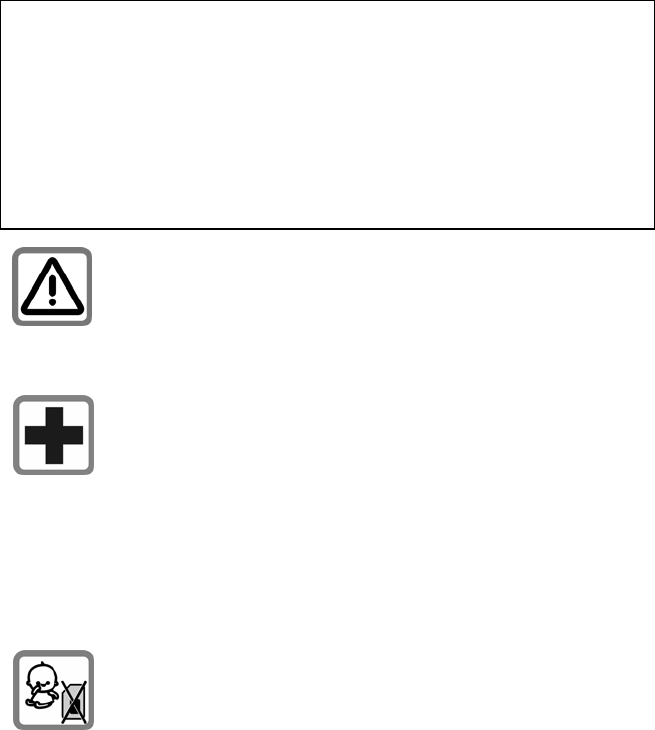
3
7.1 WIRED EARPHONE......................................................... 57
7.2 BLUE TOOTH EARPHONE................................................ 57
7.3 BLUE TOOTH ADAPTER .................................................. 57
7.4 USB.............................................................................. 57
7.5 CHARGER...................................................................... 58
8. APPENDIX I TROUBLESHOOTING......................59
9. APPENDIX II ABBREVIATIONS AND
EXPLANATION .................................................................. 65
4
1. Safety Precautions
Information for parents
Please read the operating instructions and safety precautions carefully
before use.
Explain the content to your children and the hazards associated with
using the phone.
Remember to comply with legal requirements and local
restrictions when using the phone, for example, in
aeroplanes, petrol stations, hospitals or while driving.
Mobile phones can interfere with the functioning of
medical devices such as hearing aids or pacemakers.
Keep at least 20 cm (9 inches) between the phone and
pacemaker. When using the mobile phone hold it to the ear which is
furthest away from the pacemaker. For more information, consult
your doctor.
Always keep the phone and accessories out of reach of
small children.
Small parts such as the SIM card, dust cap, lens ring and
lens cap as well as the microSD card can be dismantled and
swallowed by small children.
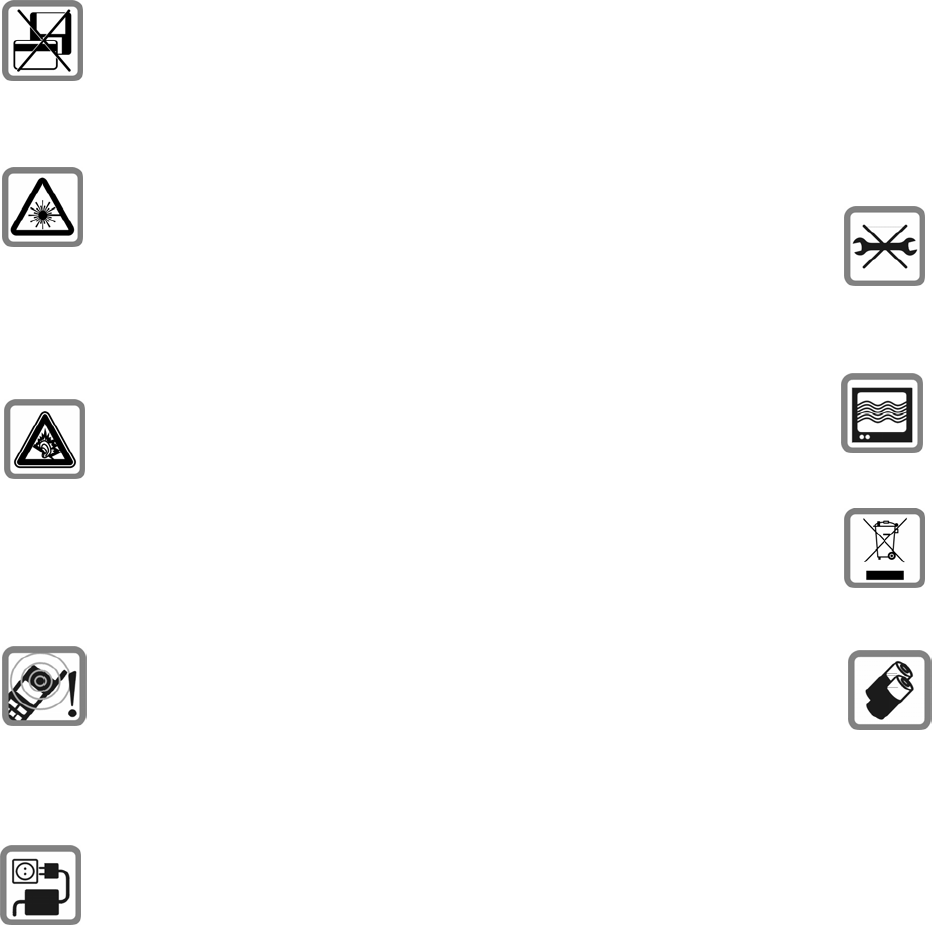
5
Do not place the phone near to electromagnetic data
carriers such as credit cards and floppy disks. Information
stored on them could be lost.
Do not look directly into the LED (such as flash LED)
with optical magnifiers because of radiation.
This product complies with IEC/EN 60825-1 “Safety of
Laser Products” for LED Class 1M products; such products are safe
under reasonably foreseeable operating conditions.
Permanent hearing loss may occur if you use earphones
or headphones at high volume. You can adapt over time to
a higher volume, which may sound normal but can be
damaging to your hearing. Set your volume to a safe level.
If you experience discomfort or buzzing in your ears, reduce the
volume or discontinue use of your earphones or headphones.
Ring tones, info tones and handsfree talking are
reproduced through the loudspeaker. Do not hold the
phone to the ear when it rings or when you have switched
on the handsfree function. Otherwise you risk serious
permanent damage to your hearing.
The mains voltage (V) specified on the power supply unit
must not be exceeded. Otherwise the charging device may
6
be damaged.
The power supply must be plugged into an easily accessible AC
mains power socket when charging the battery. The only way to turn
off the charging device after charging the battery is to unplug it.
You may only open the phone to replace the battery, SIM
and microSD card. You must not open the battery under
any circumstances. All other changes to this device are
strictly prohibited and will invalidate the guarantee.
The phone may cause interference in the vicinity of TV
sets, radios and PCs.
Dispose of unwanted batteries and phones as permitted by
the laws in your countries.
Only use original batteries and charging devices.
Otherwise you risk serious damage to health and property.
The battery could explode, for instance.
All batteries can cause property damage, injury or burns if a
conductive material such as jewelry, keys or beaded chains touch
exposed terminals. The material may complete an electrical circuit
and become quite hot. Exercise care in handling any charged battery,
particularly when placing it inside your pocket, purse or other
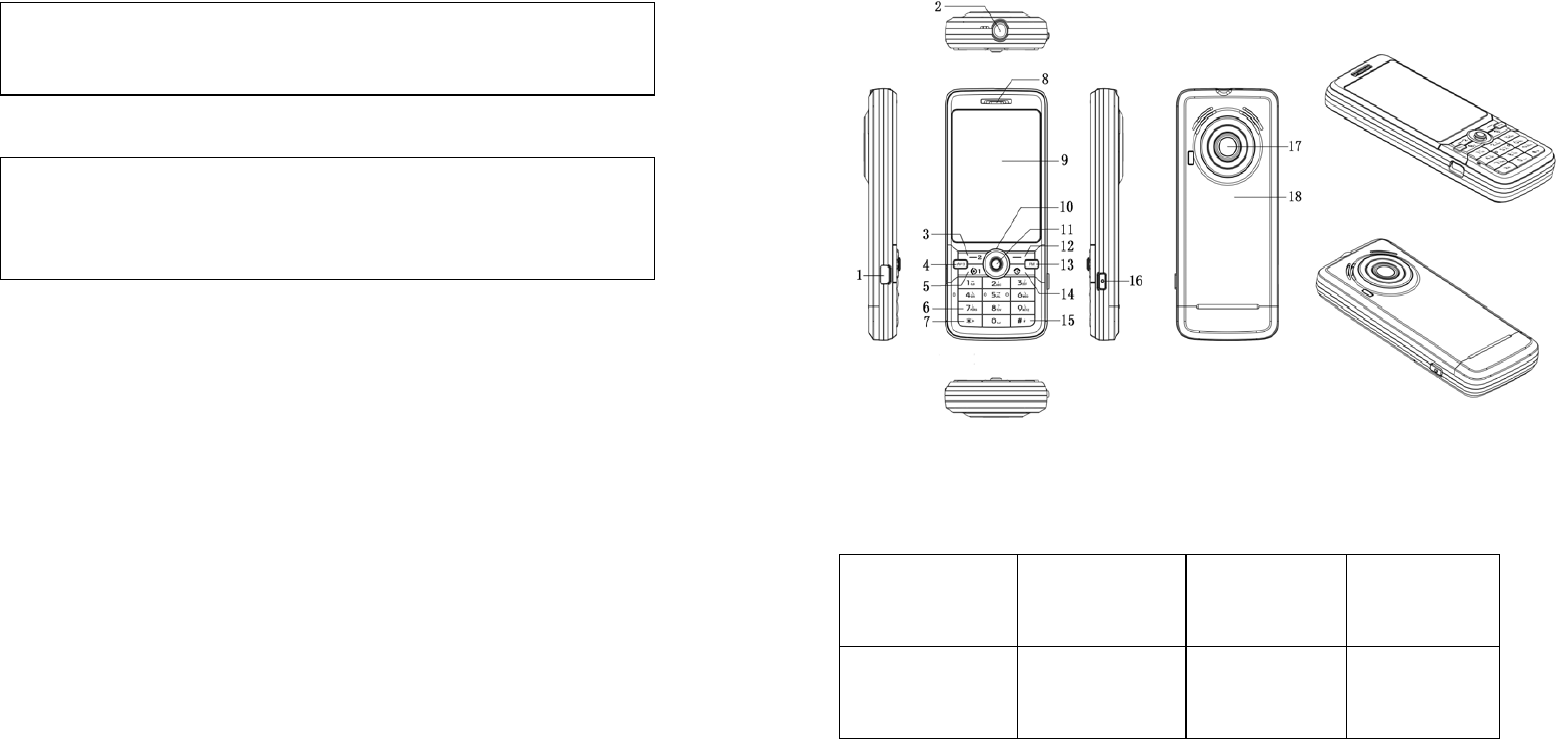
7
container with metal objects.
Do not dispose of batteries in fire as they may explode.
Improper use will invalidate the guarantee! These safety instructions
also apply to original accessories.
As mobile devices offer a range of functions, they can be used in
positions other than the head, such as directly on the body. In this
case, the limits are met too.
8
2. Phone Overview
1.Connection
jack
2.Earphone
plug-in
3.Left
soft key
4.MP3
key
5.Calling
key 6.Number key 7.Asterisk
key 8.Earpiece

9
9.Display 10.Direction
key 11.OK key 12.Right
soft key
13.FM key 14.Ending
key
15.Pound
key
16.
Photo key
17.
Camera
18. Battery
cover
Communication control keys
Calling key is used to make a call after a number has been entered or
selected from the phone book, or to answer an incoming call. In idle
screen, press calling key to show call logs of SIM1.
Ending key is used to end a call during calling or conversation, or to
quit the menu and return to idle screen. Press and hold the ending key
for about two seconds to turn the phone on/off.
Direction keys
Go to Settings > Phone setup > Dedicated key to set direction keys.
OK key
In idle screen, press the OK key to open the main menu. In lists and
menus, press the OK key to start an application/function.
Left and right soft keys
In idle screen, press the left soft key to access dialed calls of SIM2,
10
and then use direction keys to scroll through the numbers. In idle
screen, press the right soft key to directly access the phone book list.
During menu operation, the current functions of the left and right soft
keys are shown in the bottom line of the screen, and they are closely
related to the current status of the phone.
In idle screen, press the left soft key and then the "*" key to unlock
the phone.
Number keys
Press number keys (0-9) to enter numbers.
Press and hold number keys (2-9) to start speed dial.
You can also use number keys to select menus. If a number is shown
before an option in menu list, you can select the option quickly by
pressing the corresponding number key.
Asterisk key
Press the asterisk key to enter "*".
Press the asterisk key twice in a row to enter "+", to make an
international call. Press the asterisk key three times in a row to enter
"P". Press the asterisk key four times in a row to enter "W".
Pound key
Press the pound key to enter "#".
Press and hold the pound key in idle screen to activate/deactivate the
Silent mode.
When in an editing screen, press the pound key to change the input
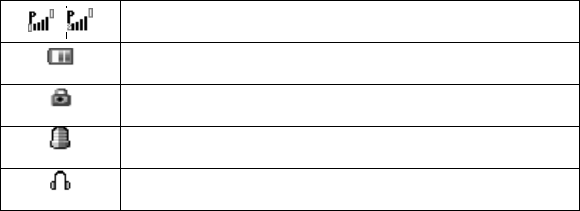
11
method.
FM key
In idle screen, press the FM key to directly access FM radio.
MP3 key
In idle screen, press the MP3 key to directly access audio player.
Connection jack
The connection jack is used to connect charger and USB cable.
Earphone plug-in
The earphone plug-in is used to connect earphone.
Photo key
The photo key is used to take photos.
Icons displayed on the main screen (Icons may be changed
without further notice)
The following icons may be displayed in the first line of the screen.
/ Signal strength
Battery status
Keypad locked
Alarm activated
Headset mode
12
3. Getting Started
What is a SIM card
When registering your mobile phone number, you will have a SIM
card (Subscriber Identity Module) provided by the network operator.
The SIM card has information reserved for your use. It includes your
phone number, PIN (Personal Identification Number), PIN2, PUK
(password to unlock PIN), PUK2 (password to unlock PIN2), IMSI
(International Mobile Subscriber Identity) number, network
information, phone book data, SMS data and so on. If it is lost,
contact your network operator immediately for help.
PIN code
PIN is the password provided by your network operator. It is usually
4 digits. When you input the PIN code, the screen displays “*” to
replace the number entered.
PIN is used to access the SIM card. If the PIN protection function is
enabled, the screen will display “Enter PIN” each time the phone is
switched on. You can deactivate this feature but you risk
unauthorized use of the phone. Some network operators do not permit
deactivating the control.
PIN2 code
PIN2 is required for some specific functions provided by the network,
such as the charge information.
Note: If you enter the PIN incorrectly three times in a row, the SIM

13
card will be locked. Please contact your network operator
immediately for decoding. Attempting to decode by yourself may
result in the permanent failure of the SIM card.
PUK code
PUK (Personal Unblocking Key, 8-digit) unlocks a locked PIN. If
you enter the PUK incorrectly ten times in a row, the SIM card will
become invalid. Please contact your network operator for a new SIM
card.
Installing the SIM card
1. Press and hold the ending key to turn off the phone.
2. Remove the battery cover and then the battery.
3. Insert the SIM card into the card holder. Ensure that the cut
corner is at the top left and the metal contacts face the phone.
4. Re-install the battery. Place the battery cover onto the back of
your phone and slide it forward until the latch catches the cover.
Note: A SIM card can be easily damaged if its metal contacts
become scratched. Therefore, take special care when holding or
inserting it and keep it away from small children.
Charging the battery
The battery is not fully charged when first unpacked. It takes three
charging-discharging cycles for the battery to reach its peak
performance. The battery can be charged and discharged hundreds of
times. However, the capacity of the battery will be reduced each time
it is charged/emptied, and it will eventually wear out. When the talk
14
time and the standby time are noticeably shorter than normal, replace
the battery. Use original batteries and charging devices only.
Unplug the charger from the outlet and the phone when not in use.
Do not leave a fully-charged battery connected to a charger because
overcharging may shorten the lifetime of the battery. If unused, a
fully-charged battery will lose its charge over time.
If the battery is completely discharged, the charging may not start
immediately when you plug in the connector. Wait 10 to 15 minutes
for the phone to begin charging.
Use the battery only for its intended purpose. Never use any charger
or battery that is damaged.
Do not short-circuit the battery. An accidental short circuit may occur
when a metallic object such as a coin, clip or pen causes the direct
connection of the positive (+) and negative (-) terminals of the battery,
for example, when you carry a spare battery in your pocket or purse.
Short circuit may damage the battery and the connecting object.
Storage at too high or low temperatures will result in a gradual
capacity loss. As a result the operating time of your mobile phone
may be considerably reduced, even after the battery is fully charged.
Do not dispose of batteries in a fire as they may explode. Batteries
may also explode if damaged. Dispose of unwanted batteries and
phones as permitted by the laws in your countries.
Battery type Standby time Call duration
Li-ion battery 200 hours More than 3 hours
15
Note: The actual operation time of a battery varies based on the
operation mode, network settings and call settings.
Charge a battery according to the following steps:
1. Connect the charger to the connection jack of the phone in
proper direction, and connect the charger to a main socket.
2. The phone displays "Charger Connected!" and starts charging
after properly connected. The battery icon dynamically displays
the charging process. In switch-off state, the phone dynamically
displays the charging process.
3. When the battery is fully charged, the charging process stops
automatically, and the battery icon indicates full grid on the
screen. After the battery is fully charged, remove the charger
from the phone and socket as soon as possible.
Note:
z After the phone has run out of battery, we recommend that you
recharge the battery in time. If you do not recharge the battery in
two days, the phone may enter the slow charging mode. When
you recharge the battery, there may be no display temporarily.
After about 10 minutes, the charging indicator icon is displayed
on the screen of the phone. If you do not recharge the battery
more than two days, the battery may enter the overdischarge
protection state. Thus, in order to get the battery into normal
charging mode quickly, we recommend that you charge the
battery on an adapter to activate the battery for charging, and
then charge the battery with the phone. Alternatively, you can
charge the battery with the adapter.
16
z Do not change the parts and accessories of the battery by
yourself or take off the battery cover for safety.
z Use only original batteries and charging devices. Otherwise you
risk serious damage to health and property.
z The temperature range for charging a battery is -10°C -55°C. Do
not charge batteries in too high or too low temperature.
z Do not use the phone while charging.
z It takes approximately four hours to fully charge a battery.
Remove the charger quickly after the battery is fully charged.
T-Flash card
T-Flash card is a kind of multimedia memory card. You can connect
the phone to a computer with a USB cable to copy and move files
between the T-Flash card and the computer. You can also browse
photo, audio and video files stored in the phone or T-Flash card by
the computer. Plug the smaller end of the USB cable into the data
cable jack of the phone, and the bigger end into the USB port of the
computer.
Switching the phone on
Press and hold the ending key to turn the phone on. The phone will
automatically search for the network, if there is no password
protection for the SIM card and the phone. After the phone is
registered on the network, the name of the service provider will be
displayed on the idle screen. Then you can make or answer a call.
The phone remains in searching state if it fails to find the available
network system temporarily.
17
After the phone is switched on, if a password is required, enter the
correct PIN code and press the left soft key or the OK key for
confirmation. After unlocked, the phone will display the name of the
registered network and the signal strength. Contact your network
operator if you do not know the PIN code. The default password of
the phone is “1122”.
After the phone is switched on, if it displays “Insert SIM Card” on
the screen, press and hold the ending key to turn the phone off, and
check whether the SIM card is properly inserted.
Switching the phone off
Press and hold the ending key to turn the phone off. After the
switch-off animation is displayed on the screen, the phone will be
switched off.
Do not attempt to turn the phone off by directly taking out the battery.
18
4. Text Entry
When an editing screen is displayed, the current text input method is
indicated in the upper left corner of the display. To have more options
to enter text, do one of the following ways to select the desired input
methods:
z Go to Settings >Settings> Phone setup > Preferred input
methods.
z In editing screen, select Options > Input method.
Changing the input method
Press the pound key repeatedly to select an input method.
Inserting symbols
Press the asterisk key and select the required symbols.
Numeric
When the input method icon is shown as "123", input numbers
directly with number keys.
Note: While using the numeric input method, you need to switch to
other text input methods to insert a space by pressing number key 0.
Multitap ABC and abc
Press a number key (2-9) repeatedly until the required letter appears
in the text. Press a key once to input the first letter listed on the key,
press it twice quickly to input the second letter, and so on.
19
Press number key 0 to insert a space. Press number key 0 twice to
enter 0.
While entering text, press the right soft key (Clear) once to delete the
last character on the display; press and hold it to delete all entered
text.
Smart ABC and abc
Press each key associated with the letter you want to enter only once.
The letters you have entered appear at the bottom of screen. The
candidate words change with each key you press. When the candidate
words are displayed, press the direction keys to choose words.
While entering text, press the right soft key (Clear) once to delete the
last character on the display; press and hold it to delete all entered
text.
Apart from Multitap ABC/abc and Smart ABC/abc, the phone also
provides Multitap PinYin、Simplified Chinese stroke、Smart PinYin、
Multitap ES/es 、Smart ES/es .
20
5. Calling
Making a call
In idle screen, after entering a phone number, press the calling key to
make a call by SIM1 or press left soft key to make a call by SIM2.
Press the ending key to end a call.
Making an international call
1. Press the asterisk key twice in a row to enter "+".
2. Enter the country code, area code and phone number.
3. Press the calling key.
Dialing an extension number
Enter the number, and then press the asterisk key three times in a row
to enter "P", or press the asterisk key four times in a row to enter "W".
Then enter the extension number.
Correcting a key-in error
Press the right soft key to delete the last character on the display.
Press and hold it to clear all entered text.
Making a call from phone book
1. In idle screen, press the right soft key to enter Phonebook list,
or enter the menu and select Phonebook.
2. Select Quick search, scroll and select a contact person

21
3. Press the calling key.
Dialing a previous number
1. In idle screen, press the calling key to display Call logs of SIM1;
or press left soft key to display dialed calls of SIM2
2. Press the up and down direction keys to select a number.
3. Press the calling key to make a call from the SIM1 card, or press
the left soft key to make a call from the SIM2 card.
Dialing a speed dial number
In idle screen, press and hold the corresponding number (2-9) in the
speed dial list to make a call. Note that number key 1 is reserved for
the voice mail number.
To set speed dial,
1. Edit the speed dial numbers in Settings > Call Setup > Speed
dial > Set number > Options > Edit.
2. Go to Settings > Call Setup > > Speed dial > Enable speed
dial to enable the function.
Listening to voice mail
Press and hold number key 1.
You need to set the voice mail number and store it on your SIM card.
To set the number, go to Messages > Voice mail server, select
Options and then Edit.
Answering a call
22
z Press the calling key.
z Press the OK key, or select Options and Answer.
Ending a call
Press the ending key.
Rejecting a call
z Press the ending key.
z Select Reject.
Call options
Press Options during a call for more options. Options vary
depending on the current situation.
Hold single
call
Hold the current call.
End single
call
End the current call.
New call Add a new call and talk with more than one party
at a time.
Phonebook Use Phonebook to search for numbers.
Message
center
Read/write a message during a call.

23
Sound
recorder
Record the call.
Mute The person on the other end of the line cannot
hear you (muting).
DTMF Enter tone sequences (number) for remote
inquiries to an answering machine.
Dual-SIM card dual-standby call
When both SIM1 and SIM2 cards of a mobile phone are in standby
state on the network, and the SIM1/SIM2 card is being used for a call,
any call of the other SIM2/SIM1 card cannot be connected.
24
6. Menus
6.1 Phonebook
The phone provides two kinds of storage media: SIM card and phone.
The phone can store 500 entries. The capacity of the phone book on
your SIM card depends on the type of SIM card provided by your
network operator.
Enter a number in idle screen and press OK key to save the number.
Select the storage location. Then the edit interface appears. If To
SIM1 or To SIM2 is selected, you need to edit the name and phone
number only. If To phone is selected, you need to edit the items that
you set in the settings of phone book, including the name, number,
home number, company name, email address, office number, fax
number, birthday, associate picture, associate video, associate sound
and caller group.
In idle screen, press the right soft key to directly access the phone
book list.
The small icon on the left of the phone book list indicates whether the
record is stored on the SIM1 card, the SIM2 card or the phone.
Call Directly call the phone number.
SIM1 IP
dial
Dial IP phone number by the SIM1 card.

25
SIM2 IP
dial
Dial IP phone number by the SIM2 card.
Send SMS Fill entry and send SMS to default phone
number.
Send MMS Fill entry and send MMS to default phone
number.
View View the detailed information of the record.
Edit Edit the options included in a phone book record.
Delete Delete the record.
Copy Copy the record from the current storage to the
other storage.
Move Move the record from the current storage to the
other storage.
Duplicate Copy the record to the current storage.
Send vCard Send vCard by SMS/MMS/Bluetooth or save it
to file.
There are the following options if you access the phone book from
menu.
26
Quick
search
This option allows quick search through phone
book. Enter the first letter. Then all the records
starting with such letter are displayed.
Search
contact
This option lets you search for a specific record.
Add new
contact
Add a new phone number to SIM1, SIM2 or
phone.
Copy all Copy the records from SIM1 to phone, from
phone to SIM1, from SIM2 to phone, from
phone to SIM2, from SIM1 to SIM2, and from
SIM2 to SIM1.
Delete You can choose to delete all the records from the
SIM1 card, SIM2 card or phone, or delete them
one by one. Note: If you want to delete all
records at once, the phone password is required,
which is "1122" by default.
Caller
groups
A caller group is the combination of phone
settings used to identify a particular group of
records. The phone provides five call groups:
Friends, Family, VIP, Business and Others. You
can manage and edit the details of caller groups.
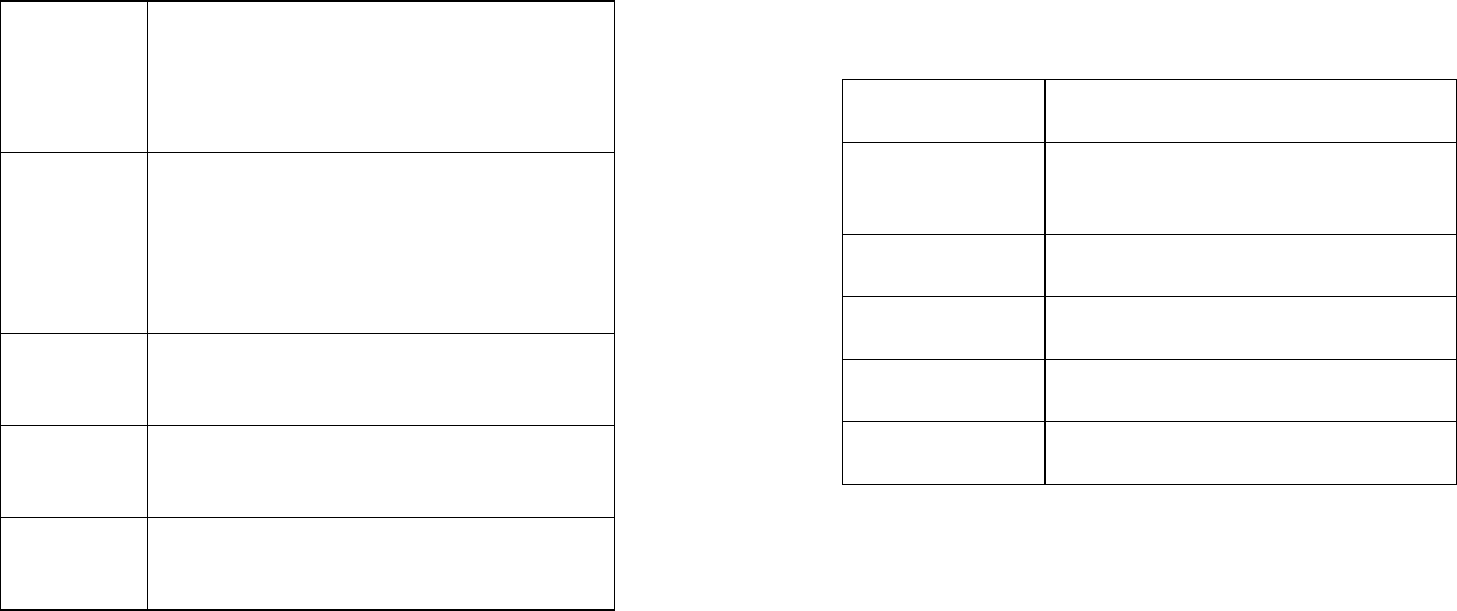
27
Extra
numbers
Set the SIM1 owner number, SIM2 owner
number, SIM1 service dialing number and SIM2
service dialing number, SIM1 SOS number and
SIM2 SOS number.
Settings View the memory status. Set the default storage
of new numbers. Select the items required to be
added when adding new numbers to the phone.
Set name list filter. Edit and send your own
vCard. Select vCard version.
Caller
picture
Set an associate picture to a new contact,
selected contact or caller group.
Caller ring
tone
Set an associate ring tone to a new contact,
selected contact or caller group.
Caller video Set an associate video to a new contact, selected
contact or caller group.
6.2 Call History
1. SIM1 call history
Viewing Call History
In idle screen, press the calling key or go to Call history > SIM1 call
history > SIM1 missed calls/ SIM1 dialed calls/ SIM1 received
calls, to view the call logs.
Select a call from the list. When the call is displayed, press the calling
28
key to call the number, or press the OK key to view the details of the
call. Select Options for more options.
Delete Delete the select number from the list.
Save to
Phonebook
Save the selected number to the SIM1
card, the SIM2 card or the phone.
Call Dial the selected number.
Edit Edit the selected number and save it.
Send SMS Send a short message to the record.
Send MMS Send a multimedia message to the record.
Delete SIM1 call log: Delete all missed calls, all dialed calls or all
received calls, or all call records on the SIM1 card.
SIM1 call time: View Last call time, Total sent and Total received,
or Reset all time of the SIM1 card.
SIM1 call cost: View Last call cost and Total cost of the SIM1 card.
You can also reset cost and set the maximum cost and the price per
unit of the SIM1 card. You may be required to enter the PIN2 code to
activate this function. It requires network support.
SIM1 SMS counter: View and reset the numbers of short messages
sent and received on the SIM1 card.
SIM1 GPRS counter: View the volume of GPRS last sent, last
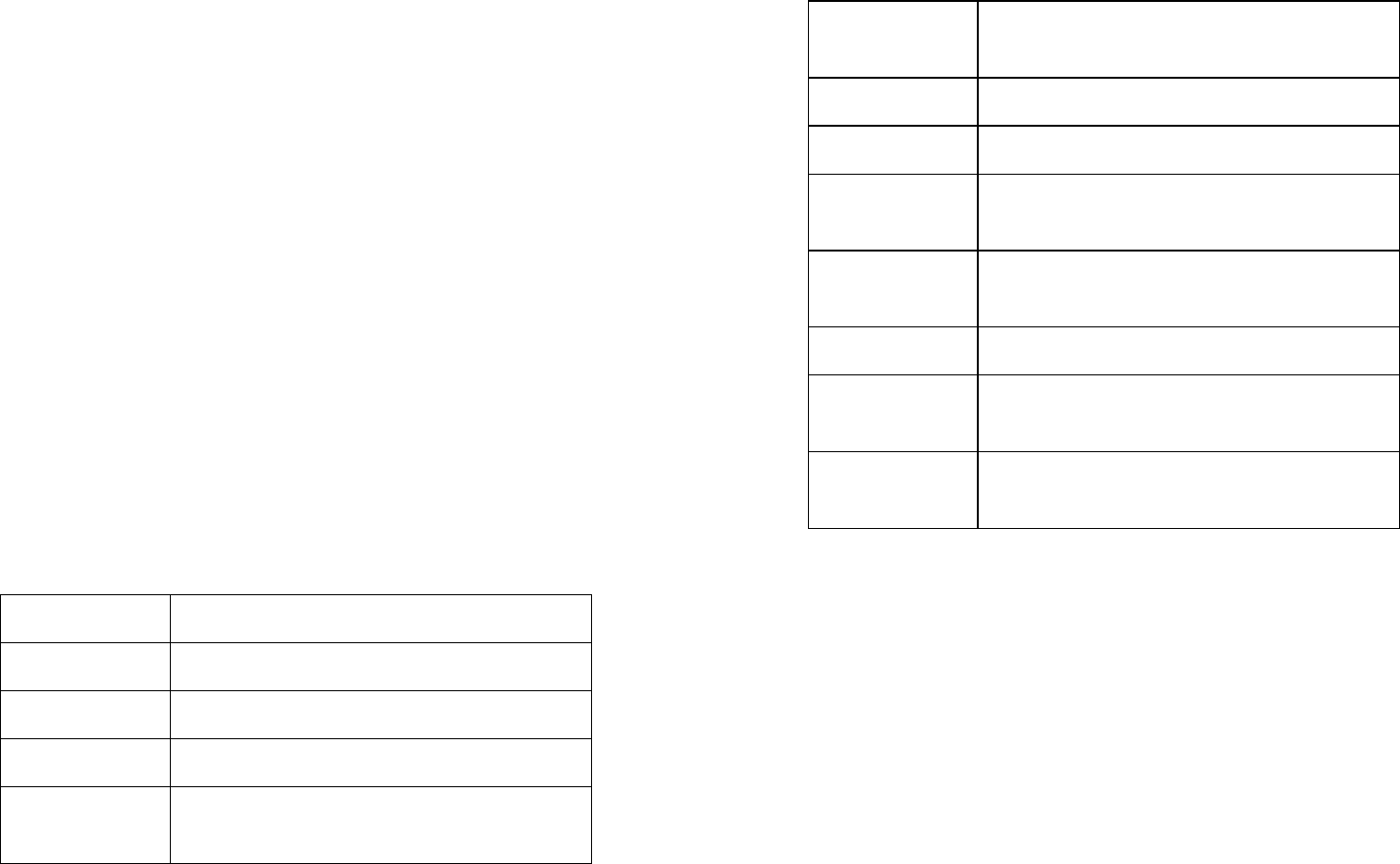
29
received, all sent and all received on the SIM1 card. You can also
reset the contents of the counter on the SIM1 card. The unit is Byte.
2. SIM2 call history
For the detailed information of SIM2 call history, please refer to the
contents in “SIM1 call history”.
6.3 Messages
6.3.1 SMS
The phone supports Short Messaging Service (SMS) and Enhanced
Message Service (EMS). You can send text messages and manage the
messages that you sent and received.
If the memory for short messages is not full, short messages will be
directly saved in the SIM card. A flashing envelop icon will appear
on the top of the main screen if the memory is full.
1. Inbox
Incoming short messages are saved in inbox.
Reply Reply the short message.
Delete Delete the short message.
Edit Edit the short message.
Forward Forward this short message to others.
Copy to
SIM/phone
Copy this short message to SIM or phone.
30
Move to
SIM/phone
Move this short message to SIM or phone.
Chat Start chat by sending short messages.
Delete all Delete all short messages in inbox.
Copy all Copy all short messages from SIM or from
phone.
Move all Move all short messages from SIM or from
phone.
Use number Extract the number in the short message.
Use URL Extract the URL information in the short
message.
Use Email
address
Extract the Email address information in the
short message.
You cannot receive new messages if the memory for messages is full.
Delete unnecessary messages.
2. Outbox
Short messages successfully sent, not sent and to be sent are saved
here.
3. Write message
Create a new short message.
1. Enter text.
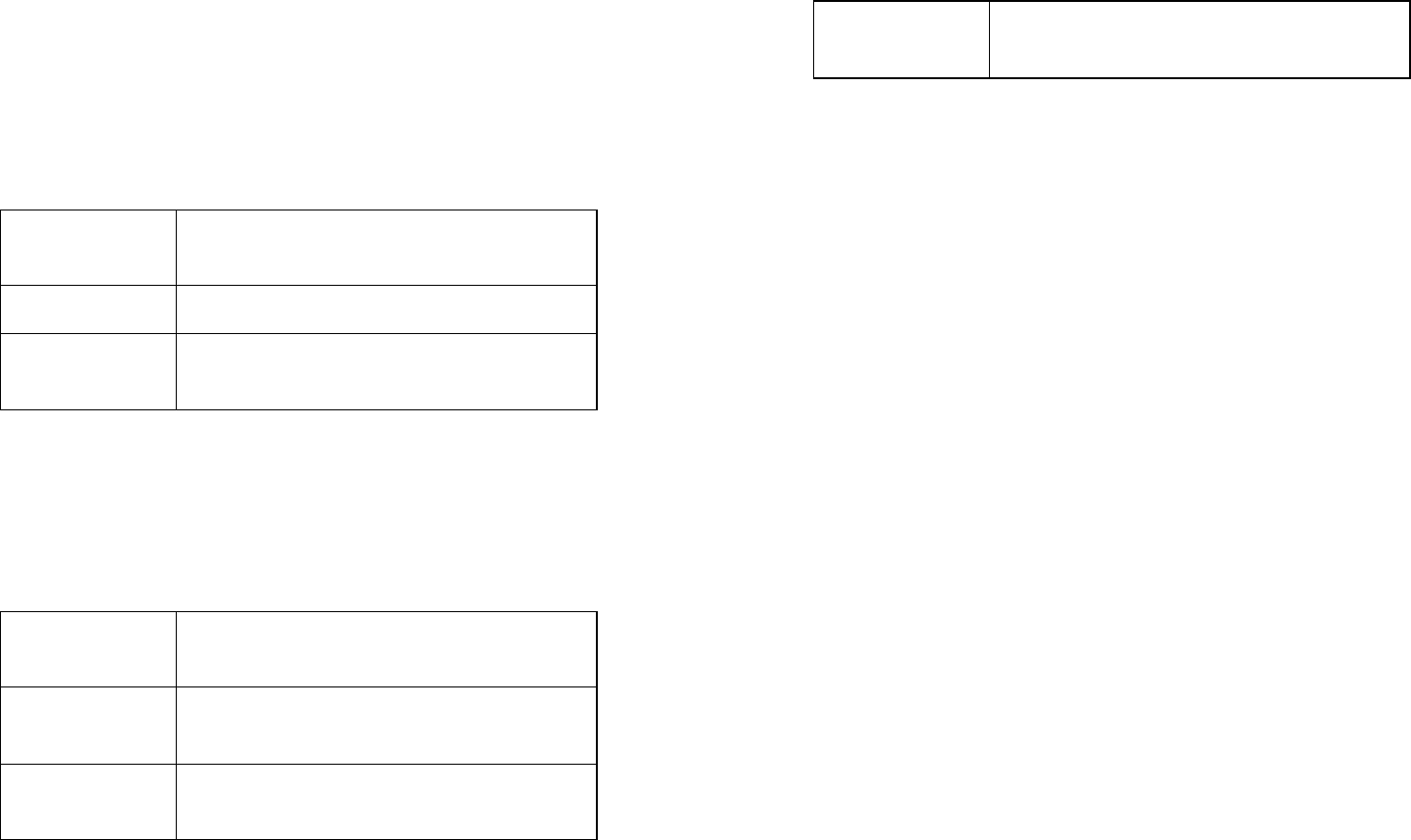
31
2. Press the left soft key (Options) and select the required items,
including SIM1 done,SIM2 down, Use templates, Insert
object, Format text, Insert number, Insert contact, Insert
bookmark and Input method.
3. Press the left soft key (Options) and select SIM1 done or SIM2
done for send options.
Send only Send the short message to the corresponding
recipient.
Send to many Send the short message to several recipients.
Send by groups Send the short message to each member of
the corresponding caller group.
4. Templates
The phone provides ten templates of text message.
5. SMS settings
Set the following settings of short messages.
Profile settings Set profile name, SC address, valid period
and message type.
Common
settings Enable or disable the delivery report and
reply path of short messages.
Memory status View the memory usage ratio of the SIM card
and phone for short messages.
32
Preferred
storage Set to save short messages to the SIM card or
to the phone.
6.3.2 MMS
The phone also supports Multimedia Message Service (MMS), which
is a network service. It enables you to send messages with images,
sounds and texts. Ask your service provider whether this service is
available. You may need to subscribe to the service from your
network operator before sending and receiving multimedia message.
All multimedia messages are stored in the memory of the phone. The
SIM card cannot store multimedia messages.
1. Write message
Create a new multimedia message.
1. Enter recipients in To by pressing the left soft key (Edit).
Confirm with Done.
2. Enter a subject in Subject by selecting Edit. Press the left soft
key (Options) and select Done.
3. Enter text in Edit content by selecting Edit.
4. Press the left soft key (Options) and select the items you want to
send, including images (Add picture), audios (Add audio),
videos (Add video), files in other formats (Add attachment),
and bookmarks (Add bookmark text) and so on.
5. Confirm the contents by selecting Options and Done.
6. Press the right soft key (Done) for send options.
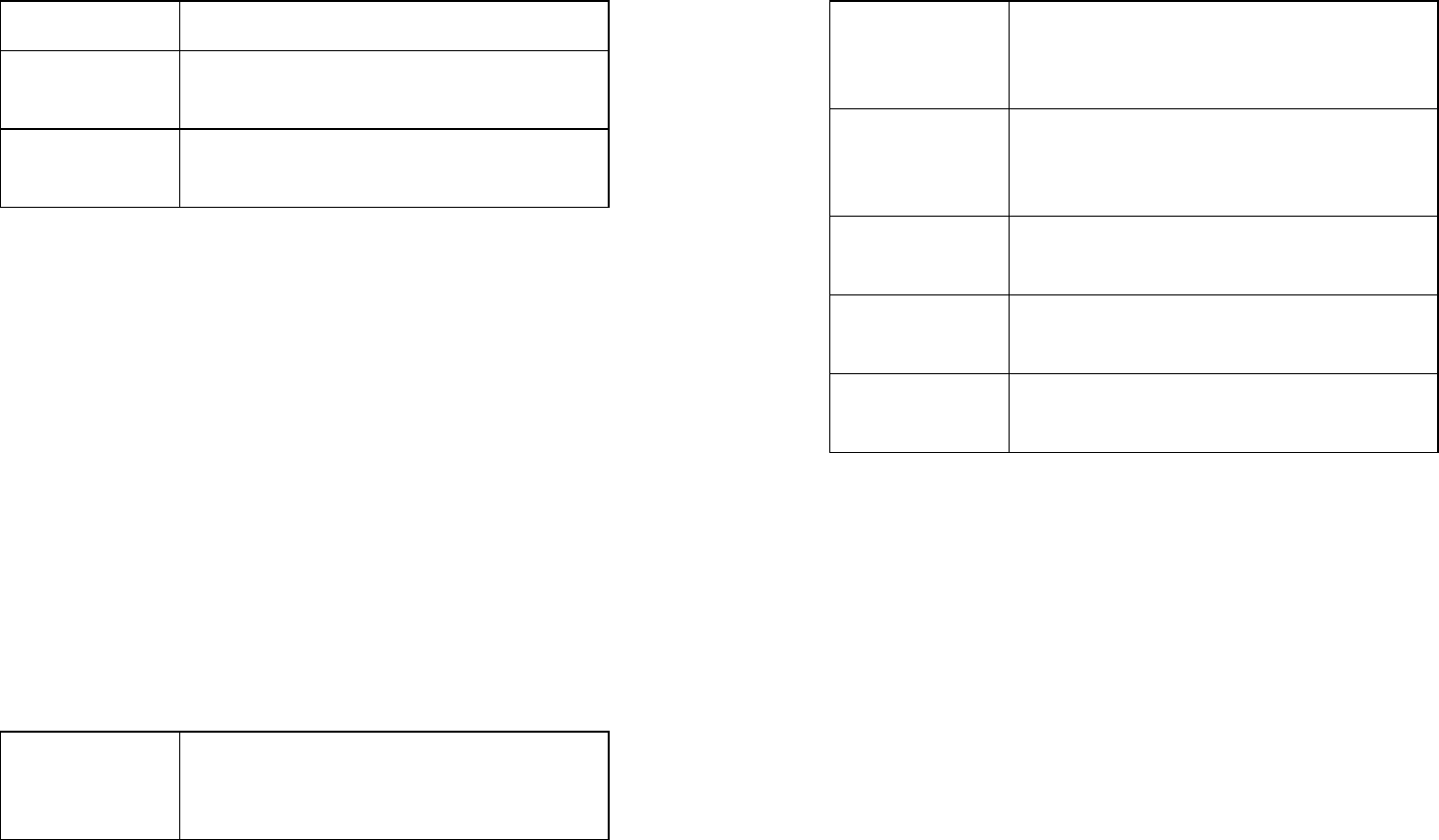
33
Save to Drafts Save the multimedia message in Draft.
Save as
template
Save the multimedia message as a template.
Exit Exit the editing of MMS. A message will
appear to ask you whether to save the MMS.
2. Inbox
Incoming multimedia messages are saved in inbox.
3. Outbox
You can view or process the multimedia messages saved in outbox.
4. Drafts
You can save a multimedia message as draft while creating it.
5. Templates
Besides user-defined templates, the phone provides five templates of
multimedia message in Default.
6. MMS settings
Set the following settings of multimedia messages.
Compose Set how a multimedia message is composed,
including creation mode, picture resizing and
auto signature.
34
Send Set validity period, delivery report, read
report, priority, slide timing and delivery time
for sending multimedia messages.
Retrieve Set home network, roaming, read report and
delivery report for receiving multimedia
messages.
Filter Your phone will reject multimedia messages
that meet the selected filter criteria here.
Server profile Activate and edit the server profile. Please
contact your service provider for settings.
Memory status View the memory usage ratio, used space and
free space for multimedia messages.
6.3.3 Chat
You can chat with one of your friends at a time in a chat room by
sending text messages to each other. You can set two chat rooms.
Note that phones from both sides must support the mobile chat
function.
6.3.4 Email
You can make emails in Email.
6.3.5 Voice mail server
Dial the voice mail number to access your voice mail. The number is
provided by your network operator.
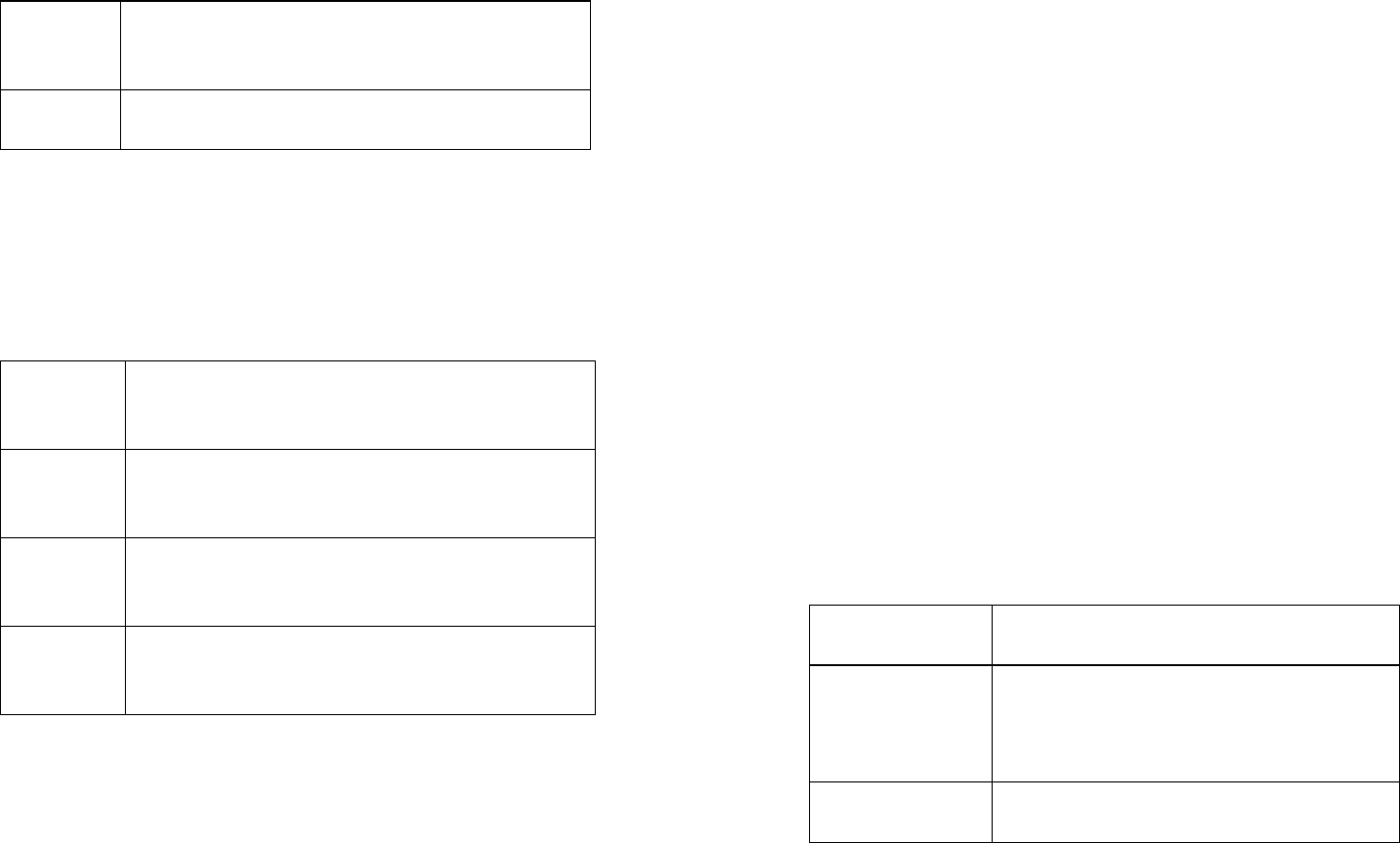
35
Connect
to voice
Connect to the current voice mailbox number.
Edit Add or change the voice mailbox number.
Note: The voice mail function requires network support.
6.3.6 Broadcast message
Broadcast messages are messages that your network operator
broadcasts to all users within a particular area, such as weather
forecast and transportation conditions.
Receive
mode
Enable or disable the function.
Read
message
Scroll to read broadcast messages.
Languages Set languages for cell broadcast information. Only
information in the set language can be received.
Channel
settings
Select the channel of cell broadcast.
For more information about available channels and the information
they provide, contact your network operator.
6.4 File manager
You can use File manager to organize your files in folders.
36
If a memory card is inserted, the files stored on it are organized
separately.
Select Phone or Memory card and select Options to browse, copy,
delete, and move the files in folders.
6.5 Multimedia
6.5.1 Camera
The phone is provided with a built-in 3.2 mega pixel CMOS camera
at the back, which supports the photographing and video shooting
functions. Pictures are saved in the file system of the phone. The file
is in the *.jpg format. You can send the pictures taken by the
MMS/Bluetooth function provided by the phone.
While in camera mode, press the left soft key to set the camera. Then
save the settings. Aim the camera lens at the place/object, and then
press the OK key to take a photo. Keep the camera lens steady for a
while for the image quality. After photographing, the still scenery just
taken is displayed on the screen.
Photos View the saved pictures.
Camera settings Set flash, Shutter sound, EV, AE meter,
Banding, Delay timer and Cont. shot of the
camera.
Image settings Set image size and image quality.
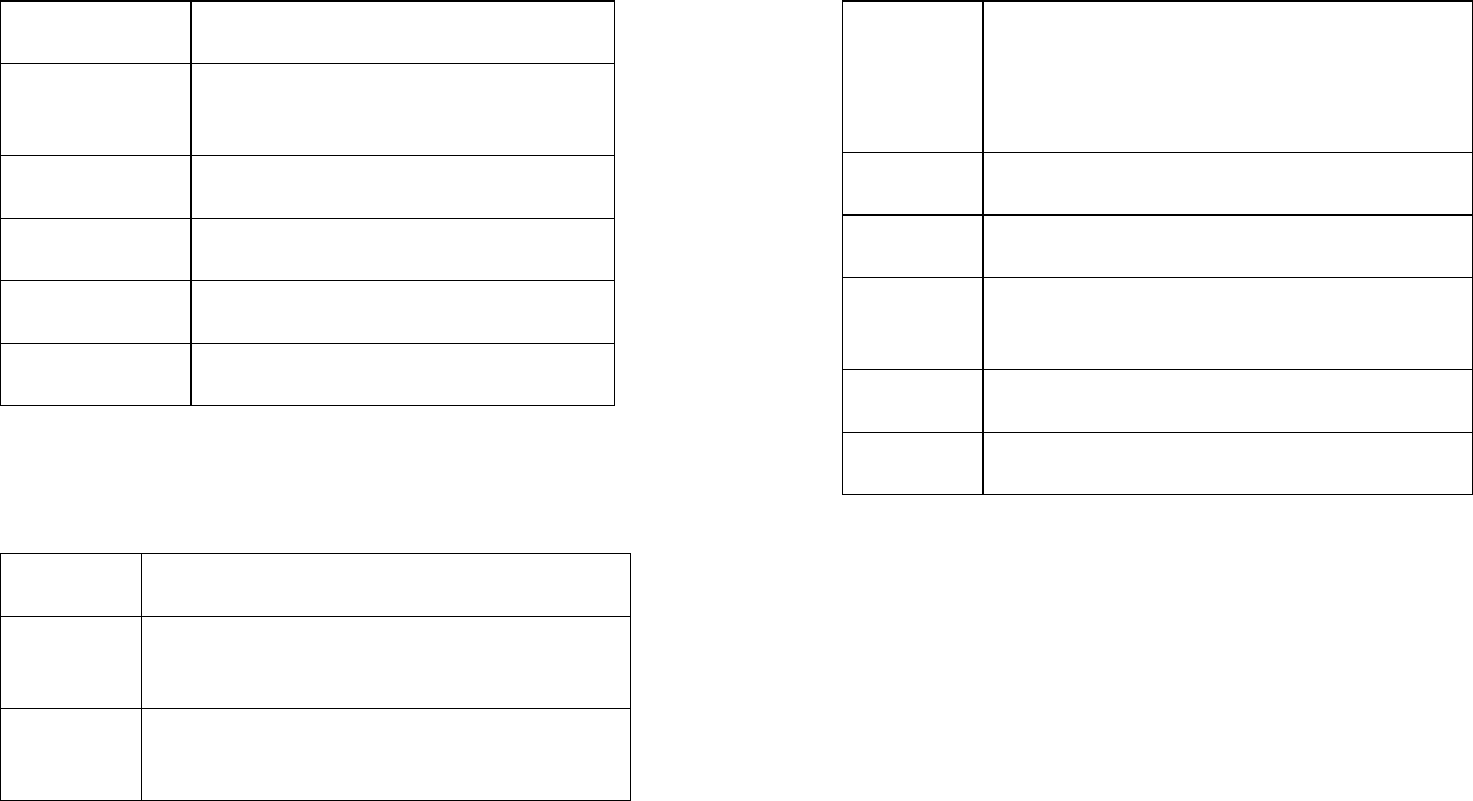
37
White balance Set light condition.
Scene mode Select pre-defined settings for the current
environment.
ISO Auto, Low, Medium or High can be set.
Effect settings Select the effect of photo display.
Storage Set the storage location for photos.
Restore default Restore the default settings of camera.
6.5.2 Image viewer
Pictures taken can be accessed quickly in Image viewer. Select
Options for available options while viewing pictures.
View Browse the pictures saved here.
Image
information
You can browse the detailed photo information
here.
Browse
style
Select List style or Matrix style.
38
Forward Set the photo as wallpaper, screen saver, power on
display, power off display or associate picture in
phone book. You can also send it through MMS or
Bluetooth.
Rename Rename the picture.
Delete Delete the picture.
Delete all
files
Delete all the pictures saved here.
Sort by Sort the pictures by name, type, time, size or none.
Storage Set the storage location of the picture.
6.5.3 Photo Editor
1. Photo Artist
You can edit the pictures stored on your phone or memory card.
1. Select Photo artist and locate an image file.
2. Select Auto resize for more options. Select Main LCD clip to
clip the image file by pressing direction keys.
Image tiles
2 or 4 or 9 image tiles can be selected.

39
6.5.4 Video recorder
Video recorder is used for video shooting. Press the OK key to start
shooting, pause or resume. Stop shooting by pressing the right soft
key. The video clip is saved to the phone or T-Flash card.
Options for Video recorder are listed below.
To player Play the saved video file.
Camcorder
settings
Set White balance, EV (Exposure Value),
Night mode and Banding of the Camcorder to
obtain the best result of video recording.
Video settings Set Video quality.
Effect settings Select the effect of video display.
Storage Select the storage location for video files.
6.5.5 Video player
Video player allows you to browse or process video recording files.
Press the OK key to play, pause or resume. Press the asterisk key to
switch between full screen and half screen.
6.5.6 Audio player
Audio player allows you to play audio files.
In idle screen, press the MP3 key to directly access audio player.
40
The phone supports T-Flash memory card. You need to save
downloaded music files to directory My Music, so that they can be
played normally.
6.5.7 Sound recorder
You can record sound, play, append, rename, delete, and delete all
files. Also you can make settings and forward the sound to User
profiles, MMS, Email and Bluetooth.
Your phone supports three kinds of recording formats: AWB, AMR
and WAV. Select a format from Settings in Options. A call may also
be recorded and saved to the phone or the memory card.
6.5.8 Melody compose
You can edit melody compose here.
6.5.9 Bluetooth
You can connect wirelessly to other compatible devices with wireless
Bluetooth technology. Compatible devices may include mobile
phones, computers and enhancements such as headsets and car kits.
You can use Bluetooth connectivity to send images, video clips,
music, sound clips and notes. Since devices with Bluetooth wireless
technology communicate by radio waves, your device and the other
device do not need to be in direct line-of-sight. The two devices only
need to be within 10 meters (33 feet) of each other, but the
connection may be subject to the interference from obstructions such
as walls or other electronic devices.
6.5.10 FM radio
This option allows you to listen to FM radio.
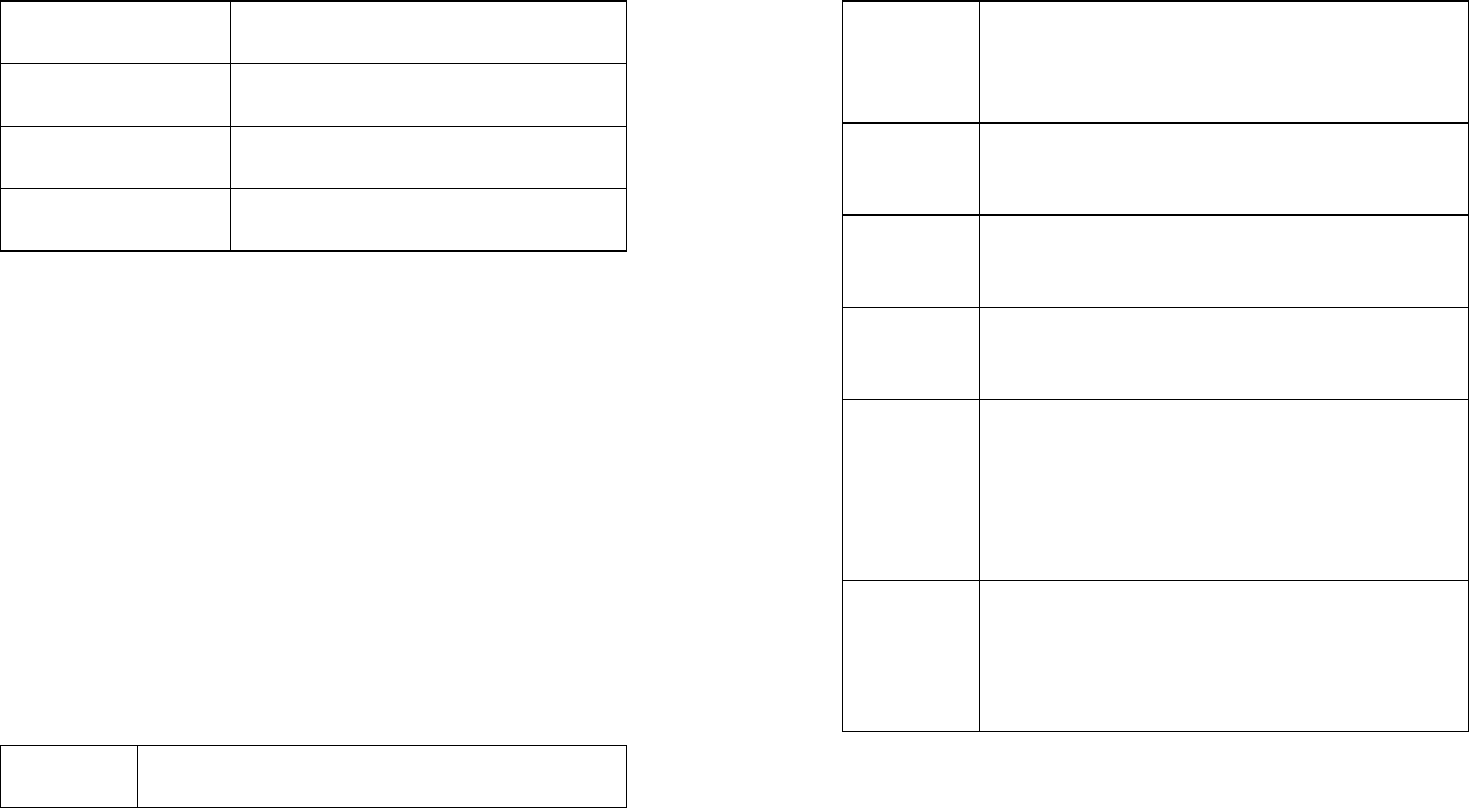
41
Channel list Edit channel list.
Manual input Input the channel manually.
Preset auto search Set automatic searching for channels.
Settings Set background play and loud speaker.
6.6 Fun & Games
Apart from Java application, the phone provides Bloxorz and
Tetris .Read Help to know how to play the game. You can set BGM,
sound effect and vibration in Games settings.
6.7 Services
6.7.1 STK
STK is shown only if it is provided by your SIM card. For further
details, please contact your network operator.
6.7.2 WAP
With the WAP function, you can use the phone to surf the Internet.
Homepage Connect browser to a homepage you set.
42
Bookmarks The phone displays a list of stored bookmarks. To
add a page to bookmarks, go to Bookmarks >
Options > Add bookmark.
Recent
pages
The phone displays the recently-visited pages.
Offline
pages
The phone displays the offline pages you saved.
Input
address
Enter the URL for direct connection to an Internet
address.
Service
inbox
This function means the service provider will send
WAP content to your phone without any operation
from you. For example, you can obtain the latest
news or new WAP setting from the service
provider.
Settings Set the browser settings, including Select SIM,
Edit profile, Browser options, Service message
settings, Clear cache, Clear cookies and Trusted
certificates.
6.7.3 Data account
The function is used to set account information.
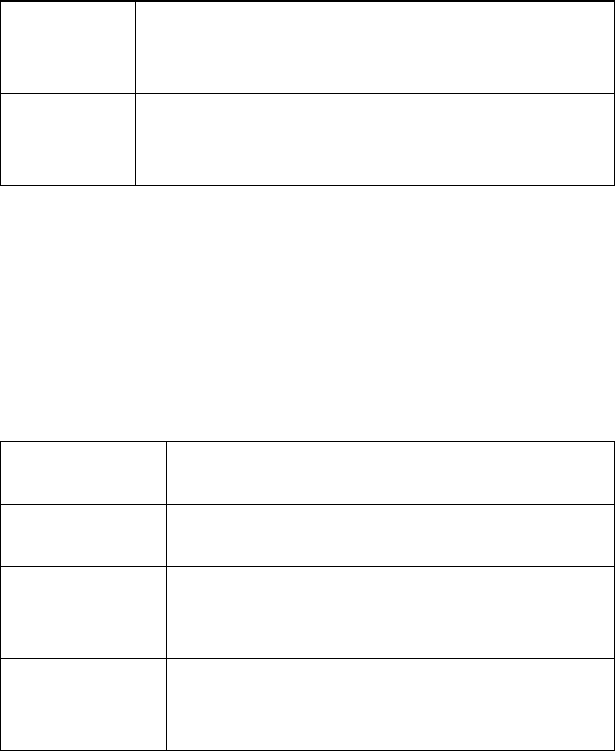
43
GSM data Press Edit to set Account name, Number, User
name, Password, Line type, Speed and DNS.
GPRS Press Edit to set Account name, APN, User
name, Password and Auth. type.
6.8 Organizer
6.8.1 Calendar
You can enter events in the calendar.
In the calendar interface, press the up and down direction keys to
scroll to different weeks, and press the left and right direction keys to
scroll to different days.
View tasks View or edit event memos for the day.
Add task Add event memos.
Jump to date Enter a specific date to be located and the
cursor will jump to the date quickly.
Go to weekly
view
View the tasks in a week.
6.8.2 To do
If activated, the phone rings as a reminder when the set time arrives.
You can view, add, edit and delete task if required.
44
6.8.3 Alarm
You can set five types of alarm clock time if required. Then the alarm
icon will be displayed on the idle screen.
Scroll to an alarm and select Edit for settings. You can set whether to
enable the alarm, the ring time, ring mode, audio options, snooze
minutes and alert type.
6.8.4 Calculator
1. Enter the amount to be calculated. Press the pound key to enter
decimal points.
2. Use navigation keys to operate and OK key to get the result.
6.8.5 Currency converter
1. Set the exchange rate and confirm with the OK key.
2. Enter the amount to be converted in Local. Confirm with the
OK key. The amount in the other currency is displayed in
Foreign.
6.8.6 World clock
You can check the current local date and time of major cities in the
world.
6.8.7 E-Book reader
The phone supports reading files in the *.txt format, which is ideal
for reading an e-Book.
Store the *.txt files in the Ebook folder, and then you can read them
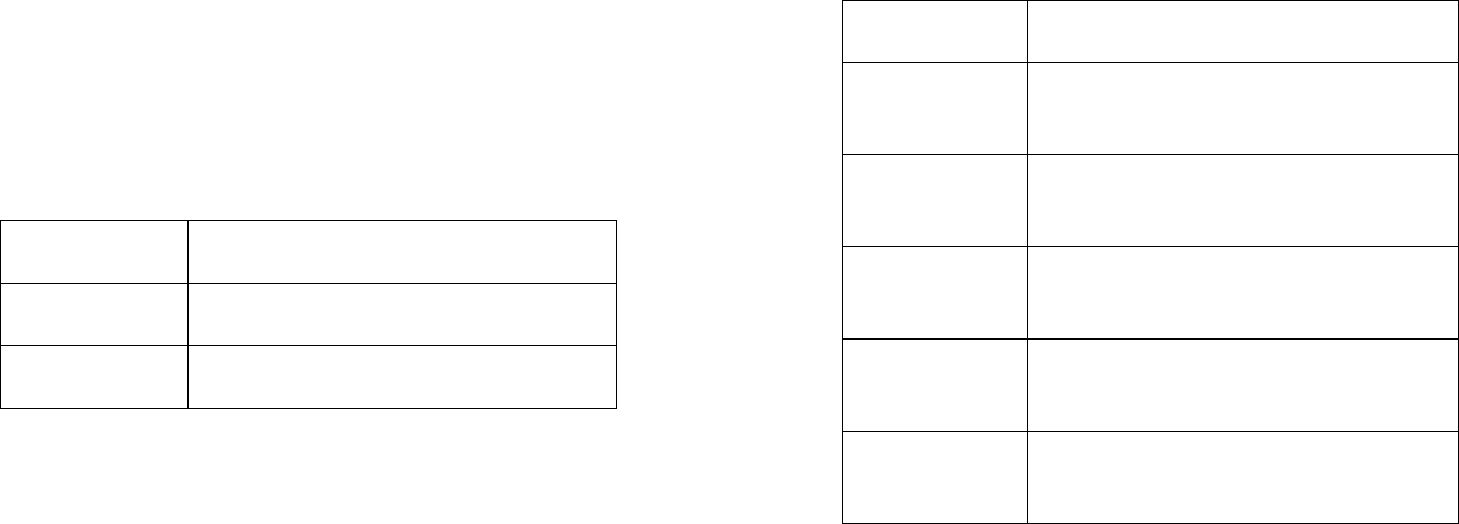
45
in E-Book reader.
6.9 Settings
6.9.1 Settings
6.9.1.1 Dual SIM settings
Set Dual SIM open, Only SIM1 open, Only SIM2 open or Flight
mode.
When you are on a flight where the use of mobile phones is
prohibited, select flight mode so that the phone will not connect to
any network. However, alarm and calendar reminder will remain on.
You can still use the entertainment features such as audio player and
camera in flight mode.
6.9.1.2 Phone setup
1. Time and date
Set home city Set your time zone.
Set time/date Set the time and the date.
Set format Set the format for the time and the data.
2. Schedule power on/off
Set the time to power on/off the phone automatically.
Warning: In specific areas where the use of phone is prohibited
(such as in aeroplanes), please remember to disable the automatic
46
switch-on function before entering the areas to prevent unexpected
accidents.
3. Language
Set current display language.
4. Preferred input methods
Set input method for text entry.
5. Display characteristics
Wallpaper Set the standby image of the phone.
Screen saver Set the waiting time and image for the screen
saver.
Power on
display
Set the animation displayed when the phone
is turned on.
Power off
display
Set the animation displayed when the phone
is turned off.
Show date and
time
If activated, date and time are displayed on
the idle screen.
Show owner
number
If activated, the phone number is displayed
on the idle screen.

47
Screen switch
effect Set on/ off for this function.
Effect switch
Choose
After switching on this effect, you can set
effect switch choice.
Clock type Analog clock or Digital clock can be
selected.
6. Greeting text
If activated, the greeting text appears when the phone is turned on.
You can edit the greeting text.
7. Shortcuts
A list of shortcuts is displayed for you to access quickly.
In the shortcut list, press the up and down direction keys or the
number keys to access the designated function.
Select Options to edit the selected shortcut.
8. Dedicated key
You can assign the navigation key as shortcuts to important functions.
Press the corresponding navigation key in idle screen to start the
function.
9. Auto update of date and time
This function requires network support.
48
If activated, the time zone is switched automatically to local time by
the network.
10. UART setup
Select the SIM1 card or SIM2 card.
11. Misc. settings
Set the brightness and time of LCD backlight. LCD backlight will be
automatically off if the phone is not operated within a specific time
period.
6.9.1.3 Call setup
1. SIM1 call settings
Caller ID
When you make a call, your number can be shown or hidden on the
display of the called party. Select Set by network to use the default
setting provided by the network operator.
You may not be able to make calls if you select Hide ID, depending
on the network setting.
Call waiting
Activate If activated, an incoming call is signaled by a
call waiting tone when you are on another call.
The number/name of the incoming call is
displayed.

49
Deactivate Cancel the call waiting function.
Query status Inquire the current status from the network.
Call divert
You can specify the conditions under which calls should be diverted
to your voice mail box or another number.
Divert all
voice calls
All calls are diverted.
Divert if
unreachable
A call is diverted if the phone is switched off or
is out of range.
Divert if no
answer
A call is diverted if not answered.
Divert if
busy
A call is diverted if another call is in progress.
Divert all
data calls
All data calls are diverted.
Cancel all
divert
Cancel all call divert settings.
Call barring
Restrict the dialing or receiving of certain calls. To activate or cancel
50
call barring, you have to enter the network password provided by
your network operator.
Outgoing
calls
If All calls is activated, no calls can be made. If
International calls is activated, no international
calls can be made. If International calls except
to home PLMN is activated, only local calls or
calls to the home country (that is, the country to
which the network operator belongs) can be
made.
Incoming
calls
If All calls is activated, no calls can be received.
If When roaming is activated, you may not
receive calls when you are outside your home
network.
Cancel all Cancel all restrictions to calls. Password from
your network operator is required.
Change
barring
password
Change barring password. The original barring
password is required.
Line switching
Switch to Line 1 or Line 2.
Note: If you select Line2, whether you can make calls is dependent
on the network operator.
Closed user group

51
This function requires network support.
1. Select OK to display Group list.
2. Select Add to enter group name.
3. Select Done and enter the serial number.
4. Select OK to complete the addition of a new group.
2. SIM2 call settings
For the detailed information of SIM2 call settings, please refer to the
contents in “SIM1 call settings”.
3. Auto redial
Once activated, the phone will automatically redial, if there is no
answer for a number you have dialed.
4. Speed dial
You can assign number keys 2 to 9 as shortcuts to important phone
numbers. Press and hold a corresponding number key in idle screen
to dial the number.
Note: Number key 1 is predefined as the speed dial key for the voice
mail number. You cannot change this function.
5. IP dial
Three sets of IP numbers may be set.
6. More
52
Call time
display
Choose whether to display the current call
duration during a call.
Call time
reminder
If activated, the phone beeps at the interval time
you set during a call.
Auto quick
end
Choose whether to activate the auto quick end
function, and set the duration.
6.9.1.4 Network setup
It requires network support.
The network that your phone uses is configured automatically. When
turned on, the phone automatically connects to the designated
network, or automatically connects to a roaming network when you
are outside the coverage of your regular network. When outside the
coverage of your regular network, you can manually select the local
network system.
1. SIM1 network setup
Network selection
Automatic The phone will scan for the available network
when you are outside the home network.
Manual The phone will list all networks for you to choose
from when you are outside the home network.
Preferred networks

53
Select the preferred network operator. The default is the network of
your SIM card.
2. SIM2 network setup
For the detailed information of SIM2 network setup, please refer to
the contents in “SIM1 network setup”.
6.9.1.5 Security setup
The phone provides several codes to protect your phone against
misuse.
1. SIM1 security setup
SIM1 lock The SIM1 card is protected against misuse by the
PIN code. SIM1 card lock may be set after you
enter the PIN code correctly.
Fixed dial You can define a list of numbers that can be dialed
by SIM1. Numbers not included in this list cannot
be dialed by SIM1.
Note: The SIM1 PIN2 code is required. Once the
PIN2 code is entered when the phone is turned on,
it is no longer required until next time the phone is
turned on.
54
Barred
dial
It requires network support. If the SIM card
supports this function, you may restrict the
numbers for outgoing calls. If activated, your
phone may not call the numbers in the Fixed dial
list. The PIN2 code is required for this setting.
Change
Password
Set new passwords, including SIM1 PIN and SIM1
PIN2.
2. SIM2 security setup
For the detailed information of SIM2 security setup, please refer to
the contents in “SIM1 security setup”.
3. Phone lock
If the phone lock is activated, the phone lock password is requested
after the phone is switched on. The default password is "1122". If the
phone is locked, only emergency calls can be made.
4. Auto keypad lock
Keypad lock prevents the inadvertent phone usage. However, you can
still be called and you can make emergency calls.
5. Change password
Set new phone password.
6.9.1.6 Restore factory settings
Reset the phone to default values (factory settings).

55
The phone password is required, which is "1122" by default.
6.9.2 User profiles
The phone provide several pre-defined user profiles that allow the
operations of the phone to best suit the environment you are in. The
profiles are General, Meeting, Outdoor, Indoor, Headset, Bluetooth,
and so on. The phone will automatically enter the headset profile if
you connect the headset.
Note: There is an extra silent mode which cannot be accessed here.
To activate that profile, go back to the idle screen, press and hold the
pound key until the phone gives you a prompt.
You can customize the following options for new profiles.
Tone setup Set SIM1 incoming call, SIM2 incoming call,
Power on, Power off, SIM1 message tone, SIM2
message tone and Keypad tone.
Volume Set volume for ring tone and key tone.
Alert type Four types of Ring, Vibration only, Vibration
and ring and Vibration then ring are available
for your selection.
Ring type Three types of Single, Repeat and Ascending are
available for your selection.
56
Extra tone You can select one or more extra tones. The
options are Warning, Error, Camp on and
Connect.
Answer
mode
If Any key is selected, you can press any key to
answer a call.
57
7. Accessory list
7.1 Wired earphone
Plung in the wired earphone so that you can use the wires
weaphone to answer and reject a phone call or to listen to
music and FM.
7.2 Blue tooth earphone
Connect the phone and blue tooth earphone so that you can
use the blue tooth earphone to answer and reject a phone
call or to listen to music.
7.3 Blue tooth adapter
Connect the phone to a computer with a blue tooth adapter so that
you can copy and move files between the T-Flash card or phone and
the computer, browse photo, audio and video files stored in the phone
or T-Flash card by the computer and so on.
7.4 USB
Plug the smaller end of the USB cable into the data cable jack of the
phone, and the bigger end into the USB port of the computer. When
select Mass storage you can connect the phone to a computer with a
USB cable to copy and move files between the T-Flash card or phone
and the computer. You can also browse photo, audio and video files
stored in the phone or T-Flash card by the computer. When select
58
Webcam, the phone can be used as a camera.
7.5 Charger
When charging the battery, the power supply must be plugged into an
easily accessible AC mains power socket. The only way to turn off
the charging device after charging the battery is to unplug it.
Declaration : Do not change the accessories by yourself. Try to
contact your supplier if you want to change your accessories.
The socket-outlet shall be installed near the equipment and shall be
easily accessible.

59
8. Appendix I Troubleshooting
If you encounter problems while using the phone, or if it performs
erratically, you can consult the information in the following table. If a
particular problem cannot be resolved by using the following
information, contact the dealer where you purchased the phone.
Problem Possible causes Possible solution
The network signal is too
weak at your current location,
for example, in a basement or
near a tall building, because
wireless transmissions cannot
effectively reach it.
Move to a location
where the network
signal can be
properly received.
The network is busy at the
current time, for example,
during peak times, because
there may be too much
network traffic to handle
additional calls.
Avoid using the
phone at such time,
or try again after
waiting a short time.
Poor
reception
You are too far away from a
base station for your service
provider.
You can request a
service area map
from your service
provider.
60
Poor network trunk quality
on the part of your service
provider.
Press the ending key
and dial again. You
may be switched to a
better-quality
network trunk or
phone line.
Echo or
noise
Poor local telephone line
quality
Press the ending key
and dial again. You
may be switched to a
better-quality
network trunk or
phone line.
The battery or battery charger
is damaged.
Contact the dealer.
The temperature of the phone
is below -10°C or higher than
55°C.
Adjust the battery
charging
environment to avoid
extremes of
temperature.
Battery will
not charge.
Poor contact between the
battery and charger.
Check all connectors
to make sure all
connections have
been properly made.

61
The standby time is related to
your service provider system
configuration. The same
phone used with different
service providers’ systems
will not provide exactly the
same length of standby time.
If you are located in
an area where
signaling is weak,
temporarily switch
off the phone.
The battery is depleted. In
high temperature
environments, battery life
will be shortened.
Use a new battery.
Shortened
standby time
If you are not able to connect
to the network, the phone
will continue to send out
signals as it attempts to locate
a base station. Doing so
consumes battery power and
will consequently shorten
standby time.
Change your location
to one where the
network is
accessible, or
temporarily turn off
your phone.
You cannot
switch your
phone on.
Battery power has been
depleted.
Recharge the battery.
SIM card
error
SIM card malfunction or
damage
Take the SIM card to
your service provider
for testing.
62
SIM card is inserted
improperly.
Insert the SIM card
properly.
Debris on the SIM card
contacts
Use a soft and dry
cloth to clean the
SIM card contacts.
SIM card invalid. Contact your service
provider.
You are not within the
service area of the network.
Check the service
area with your
service provider.
Unable to
connect to
the network.
Poor signal. Move to an open
space, or if you are
inside a building,
move closer to a
window.
You cannot
answer
incoming
calls.
You have activated the call
barring feature.
Go to Settings >
Call Setup>
SIM1/SIM2 call
settings > Call
barring, and then
select Cancel all.

63
You have activated the call
barring feature.
Go to Settings >
Call Setup>
SIM1/SIM2 call
settings > Call
barring, and then
select Cancel all.
You cannot
make
outgoing
calls.
You have activated the fixed
dial number feature.
Go to Settings >
Security setup >
SIM1/SIM2
security setup >
Fixed dial, and
select Off to disable
this feature.
PIN Code is
blocked.
You have entered an
incorrect PIN code three
consecutive times.
Contact your service
provider. If the
service provider
provides the PUK
code of the SIM
card, use the PUK
code to unlock the
SIM card.
Unable to
enter
information
into the
phone book.
The memory of the phone
book is already full.
Delete unnecessary
data from the phone
book.
64
Unable to
select
certain
features.
Your service provider does
not support these features, or
you have not applied for
services that provide these
features.
Contact your service
provider.

65
9. Appendix II Abbreviations and Explanation
GSM Global System of Mobile Communication
GPRS General Packet Radio Service
SMS Short Message Service
WAP Wireless Application Protocol
FDN Fixed Dialing Numbers
SIM Subscriber Identity Module
PIN Personal Identification Number
PUK Personal Unblocking Key
IMEI International Mobile Equipment Identity
MCC Mobile Country Code
MNC Mobile Network Code
66
Call waiting
A service provided by the network, which allows you
to answer another incoming call without interrupting
the active call, but it is different from conference call.
You can only talk to one party while another party is
held at the same time.
Call divert
A service provided by the network, which allows you
to divert an incoming call to a specified number
according to different circumstances.
Roaming
The phone is not used in the area of its local
registered network. It includes international and
domestic roaming. In this manual it refers to
international roaming only.
STK SIM Toolkit
67
10. Appendix III RF Exposure Information
The SAR limit of USA (FCC) is 1.6 W/kg averaged over
one gram of tissue. Device types G6300 (FCC ID:
QISG6300) has also been tested against this SAR limit. The
highest SAR value reported under this standard during
product certification for use at the ear is 1.459 W/kg and
when properly worn on the body is 0.237 W/kg. This
device was tested for typical body-worn operations with the
back of the handset kept 1.5cm from the body. To maintain
compliance with FCC RF exposure requirements, use
accessories that maintain a 1.5cm separation distance
between the user's body and the back of the handset. The
use of belt clips, holsters and similar accessories should not
contain metallic components in its assembly. The use of
accessories that do not satisfy these requirements may not
comply with FCC RF exposure requirements, and should
be avoided.
This device complies with part 15 of the FCC rules.
Operation is subject to the following two conditions: (1)
this device may not cause harmful interference, and (2) this
device must accept any interference received, including
68
interference that may cause undesired operation.
NOTE: The manufacturer is not responsible for any radio
or TV interference caused by unauthorized modifications to
this equipment. Such modifications could void the user’s
authority to operate the equipment.
NOTE: This equipment has been tested and found to
comply with the limits for a Class B digital device,
pursuant to part 15 of the FCC Rules. These limits are
designed to provide reasonable protection against harmful
interference in a residential installation. This equipment
generates uses and can radiate radio frequency energy and,
if not installed and used in accordance with the instructions,
may cause harmful interference to radio communications.
However, there is no guarantee that interference will not
occur in a particular installation. If this equipment does
cause harmful interference to radio or television reception,
which can be determined by turning the equipment off and
on, the user is encouraged to try to correct the interference
by one or more of the following measures:
- Reorient or relocate the receiving antenna.
- Increase the separation between the equipment and

69
receiver.
-Connect the equipment into an outlet on a circuit
different from that to which the receiver is connected.
-Consult the dealer or an experienced radio/TV technician
for help